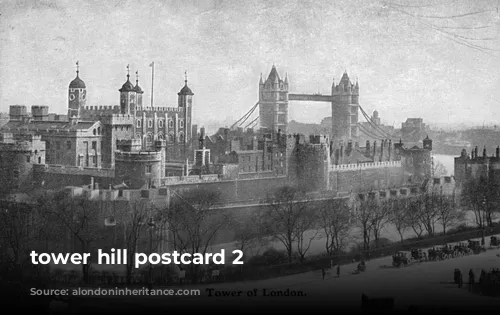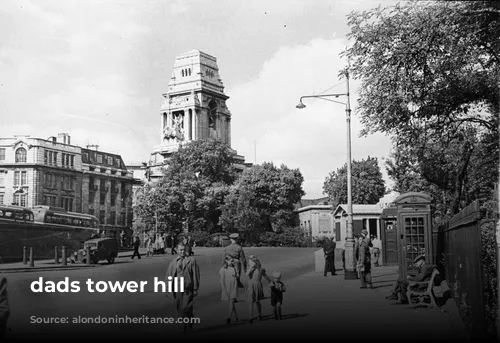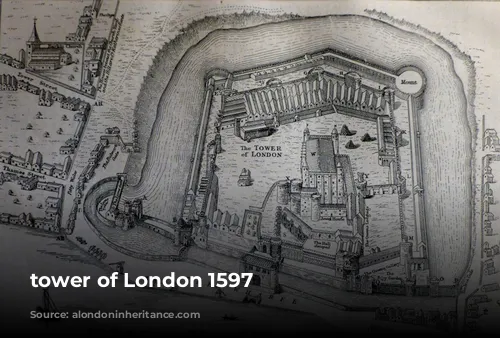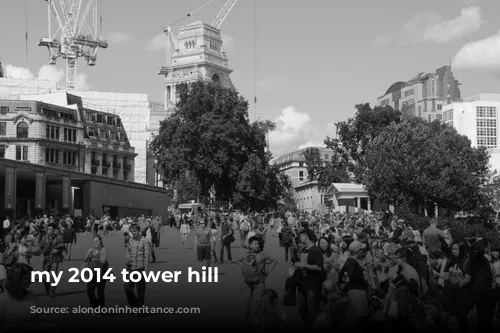London’s ever-changing landscape is a fascinating story, and while we’ve explored the physical modifications, this week, we’ll use photographs to delve into another kind of change – the evolution of Tower Hill into a global tourism hub.
A Historic Landscape
Tower Hill, nestled alongside the imposing Tower of London, holds a rich and complex history. In the words of the historian John Stow, this area was once a vast expanse of land, gradually encroached upon by gardens and dwellings. However, Tower Hill also served as a grim execution ground, its scaffold witnessing the tragic ends of numerous traitors and criminals.
Lord Lovat’s execution in 1747 stands out as a particularly tragic event. A scaffolding built to accommodate spectators tragically collapsed, claiming the lives of twelve people.
The photos we’ll explore paint a vivid picture of Tower Hill’s metamorphosis from a place of somber history to a bustling tourist destination.
A Gateway to History
This 1597 survey captures Tower Hill’s significance as the main land-based entrance to the Tower of London. Countless individuals, some facing dire circumstances, would have traversed this path towards the Tower’s imposing walls.
The moat surrounding the Tower, once considered a “nuisance,” was drained in 1843. This act revealed hidden remnants of the past – stone shot fired during a siege in 1460. These objects offer tangible evidence of past conflicts and the Tower’s role as a fortified stronghold.
A Century of Change
A postcard from the early 1900s presents us with a Tower Hill alive with activity. The iconic Tower of London looms large, and transportation lined up along the approach transports visitors to and from the historic fortress.
A photograph taken by the author’s father in 1948 showcases a slightly different scene. The Port of London Authority headquarters, a majestic structure designed by Sir Edwin Cooper, now dominates the skyline. Its “massive tower” became a prominent local landmark, visible from both the surrounding streets and the River Thames.
The nearby colonnaded building serves as a poignant memorial to the sailors who perished in World Wars I and II. Inscribed with the names of over 36,000 men who “have no grave but the sea,” it stands as a solemn reminder of the sacrifices made during these conflicts.
Capturing Moments in Time
These photos offer a captivating glimpse into the evolution of Tower Hill. From the ice cream vendor in 1948, whose cart would later be purchased for a boy in the photo, to the ubiquitous police boxes that have gained fame as the Tardis, these details paint a vivid picture of daily life in post-war London.
A photograph taken in 1977 captures the emergence of mass tourism. Coaches transport eager visitors, and telephone boxes for intercontinental calls highlight the changing global landscape.
Fast-forward to 2014, and the photograph shows a Tower Hill transformed. Cranes, a ubiquitous feature in modern London, now dot the skyline. The Tower of London, surrounded by new ticket offices, food outlets, and visitor displays, stands as a major draw for tourists from around the globe.
A Legacy of Change
The stark contrast between these photos underscores the remarkable transformation of Tower Hill. Gone are the telephone boxes and the ice cream vendor; they are replaced by a bustling tourism infrastructure catering to millions of visitors annually.
London’s tourist numbers have skyrocketed in recent decades. The Tower of London, once a symbol of history and power, has become one of the city’s most popular attractions.
Tourism continues to shape London’s landscape, and its influence will undoubtedly continue to grow.
A Nighttime Escape
For a glimpse of Tower Hill’s past, consider a visit late on a cold winter’s evening. With the crowds dispersed, you can enjoy the tranquility of the moat and the Tower’s imposing silhouette, imagining it as a functioning garrison, fortress, and prison.
For a unique historical experience, attend the Ceremony of the Keys. This nightly ritual, dating back at least 700 years, offers a glimpse of the Tower’s past and present.
Tower Hill’s story is a testament to London’s dynamism and the enduring allure of its history. Through these photographic snapshots, we witness a remarkable journey – from a place of execution to a global tourist hub.

Reference photo



